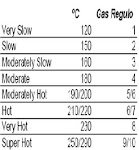 Hi all! Sorry for not being able to update lately. Was vacay-ing with the family during the weekend and have just been really caught up with work and life. Anyway, in this post I'm sharing with you guys the essential pots and pans that you should own in your kitchen so that you can basically cook anything you want at anytime!! Pots and pans come in different sizes and materials. And they are different for different types of cooking. The first part of this 3- part Kitchen Essentials - Pots and Pans You Should Have will be knowing what type of materials your pots and pans are and what difference do they make to own different types. This is because, different types of materials can affect how much they cost, how they hold heat, how easy they are to clean, etc. Here are the five most common materials for pots and pans.
Hi all! Sorry for not being able to update lately. Was vacay-ing with the family during the weekend and have just been really caught up with work and life. Anyway, in this post I'm sharing with you guys the essential pots and pans that you should own in your kitchen so that you can basically cook anything you want at anytime!! Pots and pans come in different sizes and materials. And they are different for different types of cooking. The first part of this 3- part Kitchen Essentials - Pots and Pans You Should Have will be knowing what type of materials your pots and pans are and what difference do they make to own different types. This is because, different types of materials can affect how much they cost, how they hold heat, how easy they are to clean, etc. Here are the five most common materials for pots and pans.The 5 Common Materials of Pots and Pans
1. Cast iron: Affordable and a terrific conductor of heat, but very heavy. Cast iron also reacts with acidic foods and can sometimes impart a metallic taste (though for more money you can avoid this problem by buying cast-iron pots and pans lined with an enamel surface). If properly seasoned, cast iron actually improves with age, becoming increasingly nonstick. To season a cast-iron pan:
- Coat any new pan with a very thin layer of animal fat, such as bacon grease.
- Bake the coated pan at 250–300°F for 1–2 hours.
- Never wash a cast-iron pan with detergent or scouring pads. Instead, scrub the pan clean while it’s still warm.
- Bake the coated pan at 250–300°F for 1–2 hours.
- Never wash a cast-iron pan with detergent or scouring pads. Instead, scrub the pan clean while it’s still warm.
2. Stainless steel: Sturdy, nonreactive, and pleasing to the eye, but expensive and a relatively poor conductor of heat. Cladded stainless steel costs more but improves heat conduction by sandwiching a layer of aluminum between layers of stainless steel.
3. Copper: Very study and a great conductor of heat, but reactive with acidic foods and very expensive—even more expensive than stainless steel.
4. Aluminum: Light and relatively inexpensive, but weak and easily warped, and also reactive with acidic foods. Some aluminum pans are anodized, which renders them nonreactive, strengthens them, and extends their life significantly.
5. Nonstick or Teflon®: Coated with Teflon®, a surface material added to pots and pans to prevent most food from sticking. Though these pans make cleanup easier, there is substantial evidence suggesting that the chemicals used to make nonstick or Teflon pans may be carcinogenic. If you do buy nonstick pots and pans, use only plastic or wooden utensils on them—metal utensils will damage the coating.
Amazing how different materials of those pots and pans you own have a huge difference in price and maintaining them is quite different for each of them isn't it?
Do stay tune for the next post as part 2 consists of the different types of SKILLETS and SAUTE PANS you should have in your kitchen!!
More recipes on your way after these Kitchen Essentials posts!!
Picture from hollandhouseware.co.uk and text (blue) from Quamut.com






